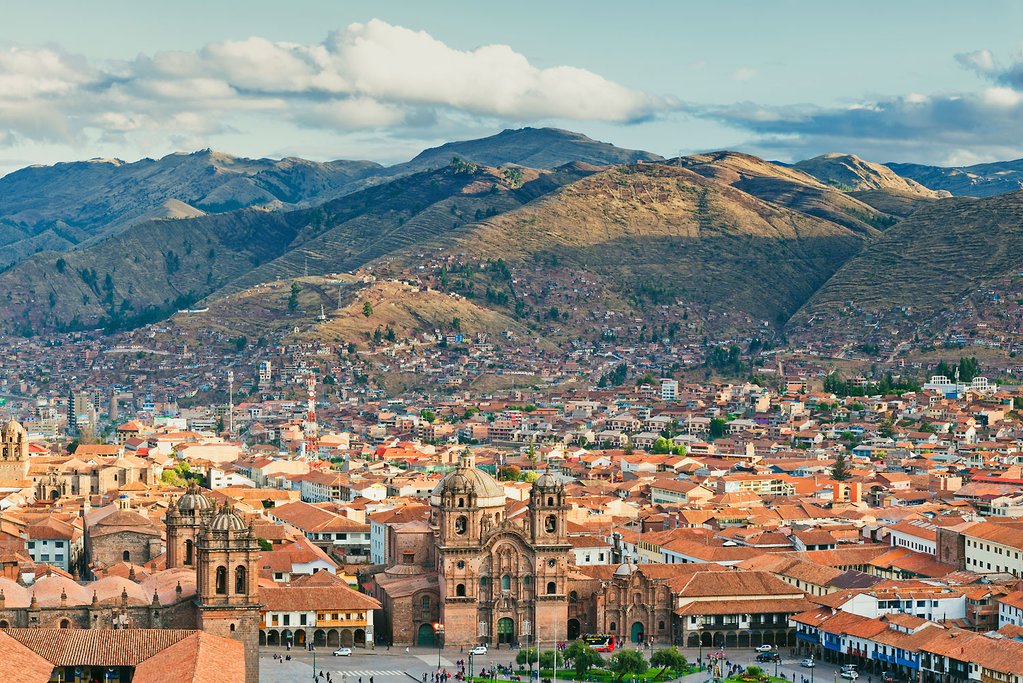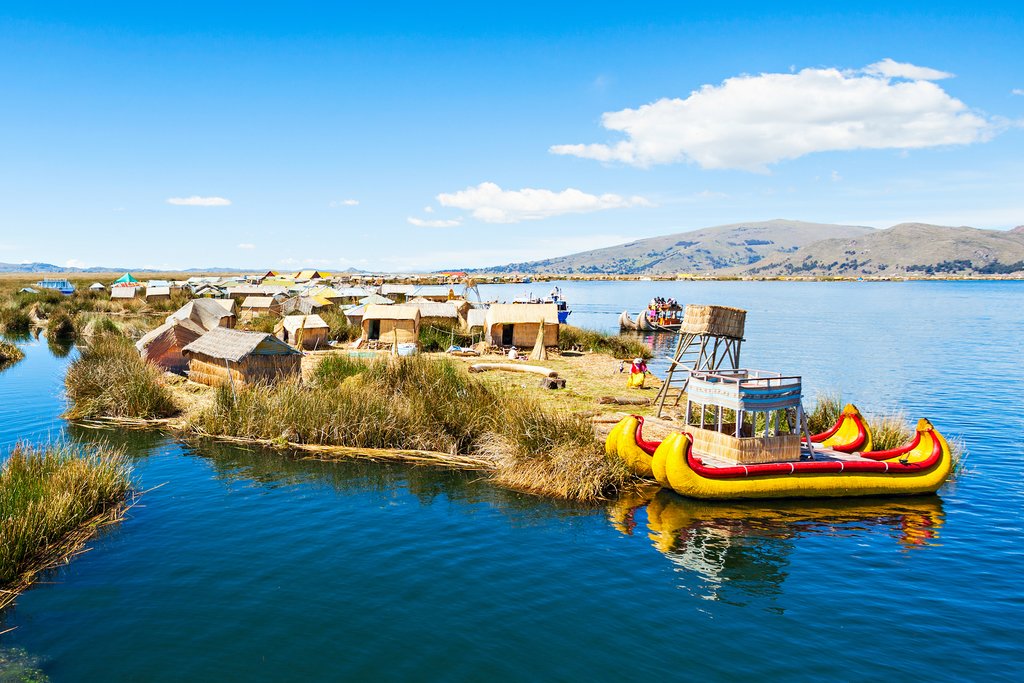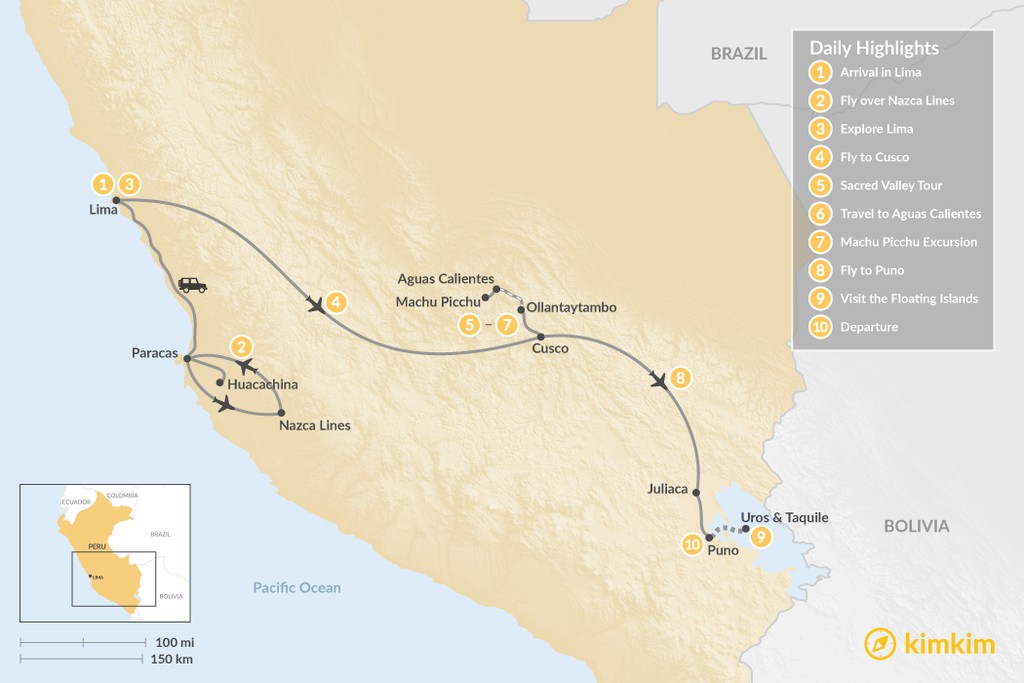
Adventurer's Trip to Peru - 10 Days

Highlights
- Get an aerial view of some of the world's most impressive geoglyphs
- Experience the history and culture of the Sacred Valley
- See the famed 15th-century Machu Picchu Citadel
- Test your adventurous side on a via ferrata and zipline
- Delve into the culture and history of Lake Titicaca
Brief Itinerary
| Day | Highlights | Overnight |
|---|---|---|
| Day 1 | Arrival in Lima | Lima |
| Day 2 | Nazca Lines & Huacachina Adventure: Lima - Nazca Lines - Huacachina - Paracas | Paracas |
| Day 3 | Free Day in Lima - History & Museums: Paracas to Lima | Lima |
| Day 4 | Arrival in Cusco, Transfer to Hotel | Cusco |
| Day 5 | Sacred Valley Tour: Cusco - Pisac - Ollantaytambo | Ollantaytambo |
| Day 6 | Via Ferrata, Ziplining, & Train to Aguas Calientes | Aguas Calientes |
| Day 7 | Machu Picchu Excursion: Aguas Calientes - Machu Picchu - Cusco | Cusco |
| Day 8 | Arriving in Puno: Cusco - Puno | Puno |
| Day 9 | Lake Titicaca Tour: Uros Floating Islands & Taquile Island | Puno |
| Day 10 | Departing Puno |
Detailed Itinerary
Day 1: Arrival in Lima

¡Bienvenidos! Welcome to Lima, Peru's largest city and central metropolitan hub, and home to one-third of the country's population. Located at the site of a pre-Columbian indigenous Ychsma settlement, which was conquered by the Inca empire in the 15th century and later by the Spanish conquistadores, Lima has a fascinating history and a diverse mix of cultures. Amerindian, European, Afro-Peruvian, and Asian—especially Chinese and Japanese—influences make Lima a dynamic and exciting city to explore.
Lima's breezy location on the Pacific Ocean and mild desert climate make it the perfect city for exploring on foot. Head downtown to mingle with locals, stretch your legs, and grab a bite to eat in one of the many award-winning restaurants.
Suggested activities include:
- Explore the historic center of Lima, a UNESCO World Heritage Site packed with fascinating Spanish architecture. Start with a scenic tour of the colonial downtown, which emanates from the main square. Stroll over to the 16th-century Cathedral, which took 80 years to construct and was built in the grandiose style of the Spanish Empire.
- Visit the Casa Aliaga, a colonial mansion granted by chief conquistador Francisco Pizarro to Jerónimo de Aliaga, one of his captains, in 1535. This is the only house from that era that still belongs to the same family.
- Stroll around the Pueblo Libre district to the privately owned Larco Museum of pre-Columbian art, housed in a beautifully restored viceregal mansion built over a 7th-century pre-Columbian pyramid. The museum boasts a vast pre-Colonial collection of gold and silver artifacts.
- In the evening, head to the eclectic "Love Park" in the upscale coastal district of Miraflores, where you can admire a huge kissing statue and beautiful mosaic walls. The park is built on the cliffs of Chorrillos and is a perfect place to enjoy a spectacular sunset over the Pacific.
- Enjoy a nightcap at an open-air cafe or restaurant in the diverse Miraflores neighborhood.
Day 2: Nazca Lines & Huacachina Adventure: Lima - Nazca Lines - Huacachina - Paracas

Your day begins with a 6:30 AM pick up from your hotel in Lima, followed by a scenic 4-hour drive along the coast south to the seaside town of Paracas. After arriving, transfer to the nearby airport in Pisco. From here you will take a 90-minute flight south aboard a 12-passenger Cessna Grand Caravan to view the sprawling Nazca Lines. You will get a chance to see many of the most famous geoglyphs, including the hummingbird, dog, tree, whale, lizard, and more.
These massive images, the longest of which are 1,200 ft (370 m), vary from geometric lines to figures of animals and people. Due to the stable environment of the Nazca desert, these geoglyphs—which were created by removing the top layer of iron-oxide coated pebbles to reveal the light-colored clay underneath—have been remarkably well preserved.
After the flight head to Huacachina for an adventure in the desert sand dunes. Hop on a sandboard to surf down the larger dunes.
In the evening, transfer to your hotel in Paracas.
Day 3: Free Day in Lima - History & Museums: Paracas to Lima

After breakfast, transfer from Paracas back to Lima. Take the rest of today to explore Lima's art, architecture, and history at your leisure. Head to some of Lima's best museums, stretch your legs, and grab a bite to eat in one of the many award-winning restaurants.
Take a ramble along the Miraflores clifftops with their lovely landscaped parks and slot in an afternoon of culture with visits to either the Museo de Arte Contemporaneo (Museum of Contemporary art) or the restored pyramid of Huaca Pucllana, a monument to the pre-Inca lima culture bizarrely jutting up in the midst of leafy Miraflores.
Allow a half day at least for exploring central Lima. Focus your explorations on the impressive Plaza Mayor. Here the impressive Cathedral contains the remains of city founder Francisco Pizarro, whilst striking facades assail you from every angle: the Moorish balconies of Palacio Arzobispal and the beautiful baroque Palacio de Gobierno, home of Peru's President. Other architectural highlights include the city's most captivating church, the Iglesia de Santo Domingo.
Next, head to the exquisite Museo Larco for a spellbinding introduction to all of Peru's ancient cultures, presented wonderfully and told through some intriguing ceramics and artifacts.
End the day by enjoying a delicious dinner at one of Lima's best restaurants, then head out for a nightcap at one of the city's celebrated cocktail bars.
Day 4: Arrival in Cusco, Transfer to Hotel

Enjoy breakfast at your hotel in Paracas before departing for Lima. Upon arrival in Lima, transfer to the airport for your flight to Cusco.
Remember: you will be 11,000 feet (3,000 m) above sea level, so take it easy and remember to drink lots of water. Take a walk through the plaza — if the weather is beautiful, it's a perfect place to sit and have a cup of coca tea while adjusting to the elevation.
In the evening, take the opportunity to experience Cusco's celebrated culinary heritage at a local restaurant.
Chat with a local specialist who can help organize your trip.
Day 5: Sacred Valley Tour: Cusco - Pisac - Ollantaytambo

In the morning, head to the Awana Kancha Llama Sanctuary, located halfway between Cusco and Pisac. Visit with the alpacas and llamas, then head over to the weaving and textiles exhibition. Local artists demonstrate the process of cleaning, spinning, dyeing, and weaving the intricate details on the colorful textiles. Afterward, browse the shop to select a piece of your own to bring home—each one is a unique and handmade treasure.
Continue to the town of Pisac, famous for its bustling textile market. Select from a wide assortment of colors, styles, and designs for gifts and souvenirs to take home with you.
Relax in the afternoon at Cerveceria del Valle, a family-owned craft brewery producing Andean-inspired ales and lagers. Join a guided tour around the brewery before a tasting session to sample the selection of beers on tap. The beer is made using the highest-quality ingredients and brewed with glacial spring water from over 13,000 feet above sea level.
From here, head to the ancient Incan city of Ollantaytambo. Explore the tranquil plaza and surrounding ruins and Inca Fortress, which offer an unparalleled view into the lives of the Inca.
Day 6: Via Ferrata, Ziplining, & Train to Aguas Calientes

Transfer from your hotel in Ollantaytambo to Pachar where you will start by climbing 1,312 ft (400 m) up the side of the cliff on the via ferrata—a series of metal steps built into the wall. From the top, descend into the valley on a series of exhilarating zip-line rides. You will then have lunch at the Skylodge Adventure Suite while enjoying the beautiful views of the Sacred Valley. After lunch, you will descend the mountain by ziplining or rappelling your way down before arriving safely at the valley floor far below you.
Later, return to Ollantaytambo to take the local train to Aguas Calientes, the base for most Machu Picchu adventures. The ride takes you through a valley and into the Urubamba River canyon, then into the cloud forest as you near the Machu Picchu sanctuary.
Aguas Calientes contains the train station, a craft market, restaurants, and a variety of hotels for those who prefer to spend the night at the foot of the mountain and climb it early in the day. Settle in and relax before your exciting day tomorrow.
Day 7: Machu Picchu Excursion: Aguas Calientes - Machu Picchu - Cusco

After an early breakfast, take the first bus up to the Machu Picchu ruins to catch the sunrise at the ancient site. This 15th-century Inca citadel is located at 7,970 ft (2,430 m) and is a masterpiece of engineering that served as a sanctuary and retreat for the Incan Emperor Pachacutec and his royal court. Machu Picchu, which means "Old Mountain," is considered a World Heritage Site by UNESCO and is one of the new Seven Wonders of the World.
Built as a seasonal residence for the Inca family, Machu Picchu was rarely home to more than 800 people, and during the royals' absence, a mere 100 servants would remain at the site to maintain the grounds. Machu Picchu was abandoned 100 years after construction due to the Spanish conquest and remained largely hidden to the outside world until the early 20th century.
Your guide will lead you around the site and explain the different buildings and curious corners of the building complex. Approximately one-third of the site has been reconstructed into its original structure, giving visitors a sense for the grandeur and artistry of the original citadel.
If you feel like an uphill challenge, you have the option to climb the infamous Huayna Picchu or Machu Picchu Mountain. It is important to know that to climb these peaks, you need to buy separate tickets in advance.
After the two-hour tour, take the bus back to Aguas Calientes to connect to your train to Ollantaytambo and your connecting transfer to Cusco.
Day 8: Arriving in Puno: Cusco - Puno

Transfer to the Cusco airport to catch your flight to Juliaca and transfer to the city of Puno, located on the shores of Lake Titicaca. Lake Titicaca is the largest lake in South America. Although many bodies of water exist at higher elevations, Lake Titicaca's surface elevation of 12,507 ft (3,812 m) makes it the highest lake in the world that is navigatable by large commercial vessels.
Lake Titicaca is a hotbed of ecological diversity, archaeological ruins, tourism, and modern-day farming communities. The coastline outside of Puro is home to the Uros people, who live on floating reed islands made from the totora plant, a thick buoyant reed. Totora is used to make everything from homes and boats to the islands nearly half the size of a football field. The Uros people offer guided tours to their homes and sell traditional handicrafts to supplement their traditional hunting and fishing economy.
Several other ethnic groups, most notably the Quechua and Taquileños, inhabit several of the other larger islands on the lake, the majority of which have no electricity or paved roads. Visitors are welcome to select homes on this island for homestays.
Photographers and naturalists will enjoy seeing some of the many hundreds of aquatic and bird species, many of which are found nowhere else on earth.
It's a good idea to take it easy on your first day and acclimatize the elevation. Drink lots of water and make sure to rest. After arrival, check out some of the town's restaurants and cafes for a fresh and local dining experience.
Day 9: Lake Titicaca Tour: Uros Floating Islands & Taquile Island

Be sure to fuel up at breakfast this morning, as this full-day experience will last around 9 hours.
Your first stop will be to one of the floating Uros islands. It is believed that the Uros were one of the first ethnic groups to populate the Andean region. The Uros people live on man-made floating islands, which are constructed out of the totora reeds that grow in abundance around the lake. During your visit to these islands, you'll learn about their everyday life and traditions.
After your visit to the floating island, you'll head to lunch at a local restaurant on Taquile Island*. Quinoa soup, fresh fish caught in the lake, and vegetables are a typical lunchtime meal in Taquile. After lunch, explore Taquile Island. This island remained mostly isolated from the outside world until the 1950s, and as a result, the Taquileños follow a very different way of life. On the island, decisions are made communally, there are no cars, and there is very little electricity - just the way the Taquileños like it. Taquile is also famous for the exquisite weavings created by local artists. Traditionally, the men spin the thread, and the women design and weave each piece. You'll have the opportunity to learn about the lives and traditions of the Taquileños, and appreciate the stunning views of Lake Titicaca from the island's shores.
In the evening, walk back to the main dock in Taquile and board a boat back to Puno. Upon arrival in Puno, transfer to your hotel for the evening.
*Note: Visiting Taquile requires a strenuous climb up 500 steps to the main part of the island. Elevation ranges from around 12,000 ft (3660 m) at the lakeshore up to 13,000+ ft (3960 m) at the highest point.
Day 10: Departing Puno

Today is your last day in Peru! You will be met at your hotel for a transfer to Juliaca Airport, where you will transfer to your departure flight. ¡Buen viaje!
